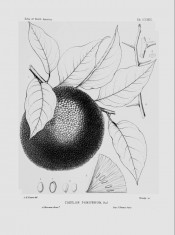Maclura pomifera (Raf.) Schneid. male and female
Fully hardy, rounded, deciduous tree, thorny when young, with ovate, pointed leaves, to 10cm long, turning yellow in autumn, and tiny yellow-green flowers, followed by large, wrinkled, yellow-green fruit, to 12cm across, on female trees. To 7m. [RHSE, Hortus, Hilliers’].
Horticultural & Botanical History
Introduced to Europe in 1818. [JD]. ‘Inquiries are beginning to be made respecting a plant which is called in the United states the Osage Orange. An American newspaper informs its readers that the Illinois Railway Company has contracted for hedging, with the Osage Orange, a hundred miles of their line. Another American journal declares it to be the best hedge plant that has been discovered in this or any other country. Professor Turner of Jacksonville says – “Our hedges are indeed splendid; when three or four years old they will turn anything. I wish you could see them in all their glory, bidding a sweet defiance to man, pig, and fowl of all sorts’. Seed was reported to be available form Messrs. Chalmers’ and Cummin’s at four shillings a pound. Unfortunately it was later reported that the seed didn’t arrive. [Gard. Chron. 1854]. ‘The actual arrival of a considerable quantity [of seed] which is held by Messrs. Charlwood and Co., Seedsmen, Covent Garden’, was announced by The Gardeners Chronicle of 1855, which also reports on its other properties: ‘the Maclura or Bow-wood, as it is more commonly called in America, is a native of Arkansas and Missouri, where it is arborescent, and grows from 50-70 feet high, and is considered one of the handsomest trees indigenous to that country. The wood when properly seasoned is of great durability and is extensively used for ship-building in preference to the live Oak. ... Various articles of furniture are also made of the Bow-wood, including chairs, tables, drawers, bedsteads, and from the refuse, a yellow dye is made. Passing from the south and west to the north and eastern states, the Maclura becomes a mere bush. Nature has given it the faculty of being made into an impassable barrier, which, when skilfully and properly made, gives strength and durability ten or twenty times greater than could be offered by an ordinary Whitethorn or Quickset hedge’. The experiences of a South Wales man ‘warrants [him] in doubting this to be a first-rate plant for our climate, for it will not grow in a dripping climate like South Wales, or if it will not bear comparison with the Whitethorn there, I fear it will not be of much value through the country generally.’ This view was supported by another correspondent: ‘Perhaps it may prevent disappointment to experimenters in this part of the country to say that Maclura grows no better here (Fifeshire) than Mr. Ayres finds in South Wales.’ [Gard. Chron. vars. refs.].
‘Toxylon pomiferum is distributed from southern Arkansas south of the Arkansas River through the southeastern portions of the Indian Territory, and southward in Texas to about latitude 35 degrees 56 minutes north. It is an inhabitant of rich bottom-lands, and appears to be most abundant and to attain its greatest size in the valley of the Red River in the Indian Territory.
An inhabitant of a region of comparatively limited area, of high winter and summer temperature and of copious rainfall, the Osage Orange, nevertheless, flourishes on the dry soil of the western prairies and in the severe climate of New England; and during the last forty years it has been more used in the western states for making live fences, or hedges, than any other plant. Its hardiness and rapid growth, the toughness of its well-armed branches, and its freedom from disease and insect enemies, make it valuable for this purpose. The good habit, the large lustrous and abundant leaves, and the beauty of the large fruits which in autumn cover the branches of the pistillate trees, make them desirable ornaments of parks and gardens.’ [Sargent – Silva of North America vol.7, p.89, pl.323/1895].
History at Camden Park
Listed in all published catalogues, the male plant as [T.654/1843] and the female plant as [T.655/1843]. Received per ‘Sovereign’ February 1831. [MP A2948]. It was used for hedging in the colony and remnants of old hedges can still be seen, often as mature trees.
Notes
Published Mar 18, 2010 - 03:01 PM | Last updated Mar 18, 2010 - 03:21 PM
| Family | Moraceae |
|---|---|
| Category | |
| Region of origin | USA |
| Synonyms |
|
| Common Name | Osage orange, Bow wood |
| Name in the Camden Park Record |
Maclura aurantiaca (mas.) - Osage Orange Maclura aurantiaca (fem.) |
| Confidence level | high |
